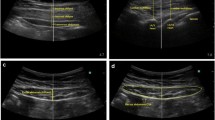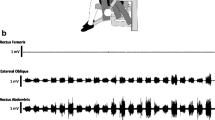Abstract
This study was conducted to examine the relationship between thigh skinfold measurement, hand grip strength, and trunk muscle endurance and compare this relationship in men and women. The current study included 200 healthy subjects (111 women and 89 men), with a mean age of 31.58±13.78 y. Trunk muscle endurance was evaluated with the use of curl-up, horizontal side bridge, and static back endurance tests. Significant differences were found between women and men in performance of the curl-up and horizontal side bridge tests (P< .05); however, no significant difference was found between the sexes in the static back endurance test scores (P≥.05). The investigators discerned a significant negative correlation between thigh skinfold measurements and all trunk muscle endurance tests in female patients (curl-up,r=−.501; horizontal side bridge,r=−.454; static back,r=−.479;P< .05). A rather weak correlation was found in male patients (curl-up,r=−.348; horizontal side bridge,r=−.182; static back,r=−.330;P< .05). On the other hand, no significant correlation was found between hand grip strength and trunk muscle endurance test scores in female patients (P≥.05), although a significant positive correlation was found in male patients in curl-up and side bridge test results (curl-up,r=.319; horizontal side bridge,r=.307; static back,r=.123;P< .05). The results of this study suggest that women have lower endurance test scores compared with men. The investigators detected the presence of a significant negative correlation between thigh skinfold measurement and trunk muscle endurance tests in both men and women and concluded that there is a positive significant relationship between hand grip strength, curl-up, and horizontal side bridge tests. Additional studies are needed to evaluate the relationship between muscle endurance and physical characteristics as they relate to the sex of the individual.
Similar content being viewed by others
References
Heyward VH.Advanced Fitness and Exercise Prescription. New Mexico: Human Kinetics Publishers; 1997:101–119.
Moffroid MT. Endurance of trunk muscles in persons with chronic low back pain: assessment, performance, training.J Rehabil Res Dev. 1997;34:440–447.
Stevens VK, Bouche KG, Mahieu NN, Coorevits PL, Vanderstraeten GG, Danneels LA. Trunk muscle activity in healthy subjects during bridging stabilization exercises.BMC Musculoskelet Disord. 2006;7:75.
Wagner H, Anders CH, Puta CH, et al. Musculoskeletal support of lumbar spine stability.Pathophysiology. 2005;12:257–265.
McKeon MD, Albert WJ, Neary JP. Assessment of neuromuscular and haemodynamic activity in individuals with and without chronic low back pain.Dyn Med. 2006;31:5–6.
Ito T, Shirado O, Suzuki H, Takahashi M, Kaneda K, Strax TE. Lumbar trunk muscle endurance testing: an inexpensive alternative to a machine for evaluation.Arch Phys Med Rehabil. 1996; 77:75–79.
Alaranta H, Luoto S, Heliovaara M, Hurri H. Static back endurance and the risk of low-back pain.Clin Biomech. 1995;10:323–324.
Singh AS, Chin A, Paw MJ, Bosscher RJ, van Mechelen W. Cross-sectional relationship between physical fitness components and functional performance in older persons living in long-term care facilities.BMC Geriatr. 2006;7:4–6.
Delmonico MJ, Kostek MC, Doldo NA, et al. Effects of moderate-velocity strength training on peak muscle power and movement velocity: do women respond differently than men?J Appl Physiol. 2005;99:1712–1718.
Biering-Sorensen F. Physical measurements as risk indicators for low back trouble over a one-year period.Spine. 1984;9:106–119.
Lariviere C, Gravel D, Gagnon D, et al. Gender influence on fatigability of back muscles during intermittent isometric contractions: a study of neuromuscular activation patterns.Clin Biomech. 2006;21:893–904.
Rodriguez G, Samper MP, Olivares JL, Ventura P, Moreno LA, Perez-Gonzalez JM. Skinfold measurements at birth: sex and anthropometric influence.Arch Dis Child Fetal Neonatal Ed. 2005;90:273–275.
O’Connor TE, Lamb KL. The effects of Bodymax high-repetition resistance training on measures of body composition and muscular strength in active adult women.J Strength Cond Res. 2003; 17:614–620.
Huttunen NP, Knip M, Paavilainen T. Physical activity and fitness in obese children.Int J Obes. 1986;10:519–525.
Ward DS, Trost SG, Felton G, et al. Physical activity and physical fitness in African-American girls with and without obesity.Obes Res. 1997;5:572–577.
Wilder RP, Greene JA, Winters KL, Long WB III, Gubler K, Edlich RF. Physical fitness assessment: an update.J Long Term Eff Med Implants. 2006;16:193–204.
Pedersen AN, Ovesen L, Schroll M, Avlund K, Era P. Body composition of 80-year-old men and women and its relation to muscle strength, physical activity and functional ability.J Nutr Health Aging. 2002;6:413–420.
Szeto GP, Lam P. Work-related musculoskeletal disorders in urban bus drivers of Hong Kong.J Occup Rehabil. 2007;17:181–198.
Smith DA, Ness EM, Herbert R, et al. Abdominal diameter index: a more powerful anthropometric measure for prevalent coronary heart disease risk in adult males.Diabetes Obes Metab. 2005;7: 370–380.
Claessens M, Claessens C, Claessens P, Henderieckx J, Claessens J. Importance of determining the percentage body fat in endurance-trained athletes.Indian Heart J. 2000;52:307–314.
Wilmore JH, Despres JP, Stanforth PR, et al. Alterations in body weight and composition consequent to 20 week of endurance training: the Herigate Family Study.Am J Clin Nutr. 1999;70:346–352.
Desrosiers J, Bravo G, Hebert R. Isometric grip endurance of healthy elderly men and women.Arch Gerontol Geriatr. 1997;24:75–85.
Moreau CE, Green BN, Johnson CD, Moreau SR. Isometric back extension endurance tests: a review of the literature.J Manipulative Physiol Ther. 2001;24:110–122.
Alaranta H, Hurri H, Heliovaara M, Soukka A, Harju R. Non-dynamometric trunk performance tests: reliability and normative data.Scand J Rehabil Med. 1994;26:211–215.
Demoulin C, Vanderthommen M, Duysens C, Crielaard JM. Spinal muscle evaluation using the Sorensen test: a critical appraisal of the literature.Joint Bone Spine. 2006;73:43–50.
Payne N, Gledhill N, Katzmarzyk PT, Jamnik VK, Keir PJ. Canadian musculoskeletal fitness norms.Can J Appl Physiol. 2000;25:430–442.
Clark BC, Manini TM, The DJ, Doldo NA, Ploutz-Snyder LL. Gender differences in skeletal muscle fatigability are related to contraction type and EMG spectral compression.J Appl Physiol. 2003;94:2263–2272.
Fink B, Thanzami V, Seydel H, Manning JT. Digit ratio and hand-grip strength in German and Mizos men: cross-cultural evidence for an organizing effect of prenatal testosterone on strength.Am J Hum Biol. 2006;18:776–782.
Carter SL, Rennie CD, Hamilton SJ, Tarnopolsky MA. Changes in skeletal muscle in males and females following endurance training.Can J Physiol Pharmacol. 2001;79:386–392.
Albert W, Wrigley A, McLean R, Sleivert G. Sex differences in the rate of fatigue development and recovery.Dyn Med. 2006;16:2–5.
Evans K, Refshauge KM, Adams R. Trunk muscle endurance tests: reliability and gender differences in athletes.J Sci Med Sport. 2006 Nov 30; [Epub ahead of print].
Eston RG, Rowlands AV, Charlesworth S, Davies A, Hoppitt T. Prediction of DXA-determined whole body fat from skinfolds: importance of including skinfolds from the thigh and calf in young, healthy men and women.Eur J Clin Nutr. 2005;59:695–702.
Raudsepp L, Jurimae T. Physical activity, aerobic fitness and fatness in preadolescent children.Sports Med Training Rehabil. 1998;8:123–131.
Bandini LG, Schoeller DA, Dietz WH. Energy expenditure in obese and non-obese adolescents.Pediatr Res. 1990;27:198–203.
DeLany JP, Harsha DW, Kime JC, Kumler J, Melancon L, Bray GA. Energy expenditure in lean and obese prepubertal children.Obes Res. 1995;3:67–72.
Deforche B, Lefevre J, De Bourdeaudhuij I, Hills AP, Duquet W, Bouckaert J. Physical fitness and physical activity in obese and nonobese Flemish youth.Obes Res. 2003;11:434–441.
Nader GA. Concurrent strength and endurance training: from molecules to man.Med Sci Sports Exerc. 2006;38:1965–1970.
Ravisankar P, Madanmohan, Udupa K, Prakash ES. Correlation between body mass index and blood pressure indices, handgrip strength and handgrip endurance in underweight, normal weight and overweight adolescents.Indian J Physiol Pharmacol. 2005;49:455–461.
Eliakim A, Burke GS, Cooper DM. Fitness, fatness, and the effect of training assessed by magnetic resonance imaging and skinf old-thickness measurements in healthy adolescent females.Am J Clin Nutr. 1997;66:223–231.
Author information
Authors and Affiliations
Corresponding author
Rights and permissions
About this article
Cite this article
Doymaz, F., Cavlak, U. Relationship between thigh skinfold measurement, hand grip strength, and trunk muscle endurance: Differences between the sexes. Adv Therapy 24, 1192–1201 (2007). https://doi.org/10.1007/BF02877765
Issue Date:
DOI: https://doi.org/10.1007/BF02877765




